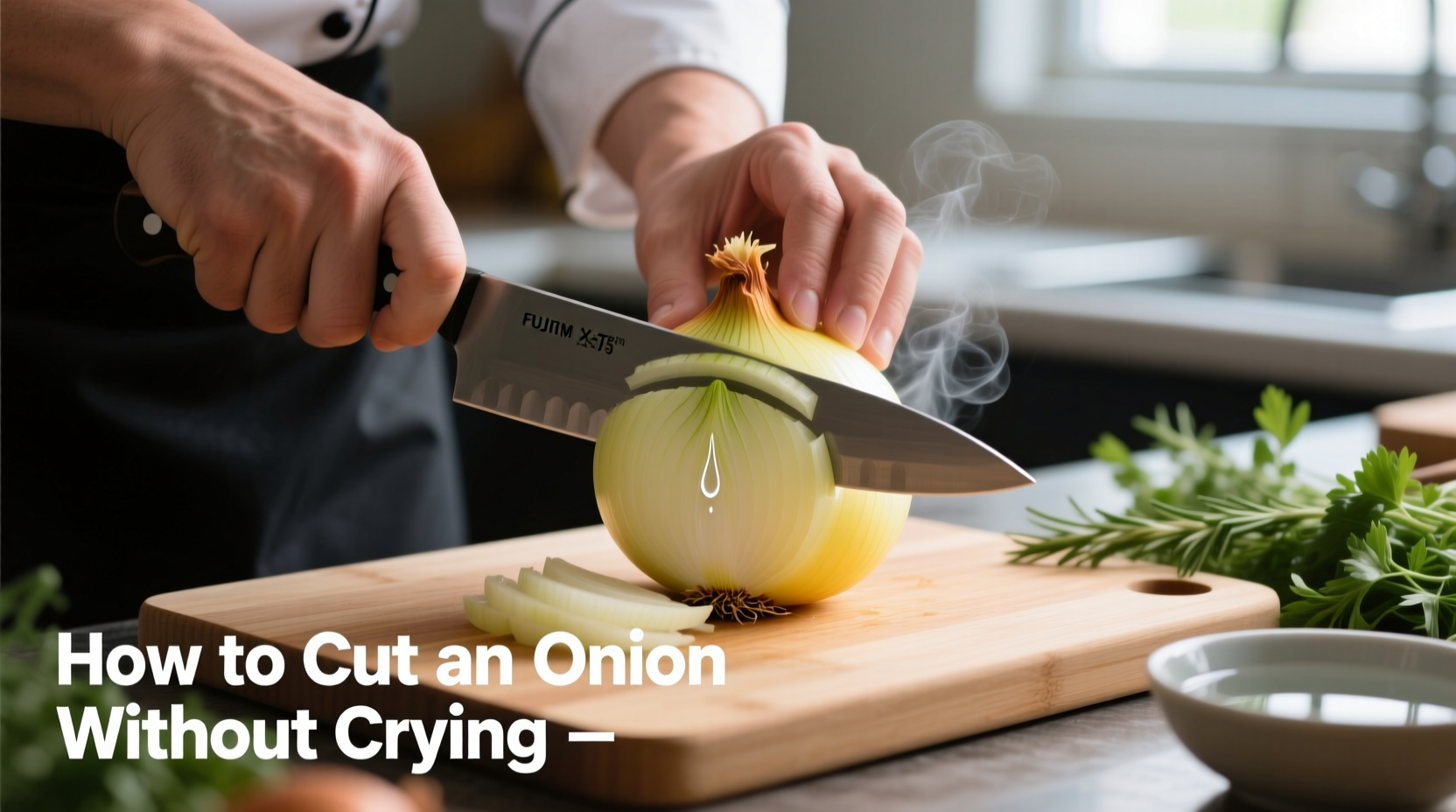The most effective way to cut an onion without crying is to chill it in the refrigerator for 30 minutes before slicing, use a sharp knife, and cut near running water or under a vent. This reduces the release of syn-propanethial-S-oxide, the compound that triggers tear production when onions are cut.
Ever wondered why slicing an onion turns you into an emotional wreck? You're not alone. Nearly 90% of home cooks experience onion-induced tears, but professional chefs rarely shed a drop. The secret isn't magic—it's science-backed technique. In this guide, you'll discover proven methods to chop onions efficiently without the waterworks, backed by culinary science and professional kitchen practices.
Why Onions Make You Cry: The Science Simplified
When you cut an onion, you rupture its cells, releasing enzymes that convert sulfoxides into sulfenic acids. These quickly rearrange into syn-propanethial-S-oxide—a volatile gas that reacts with your eyes' moisture to form sulfuric acid. Your body responds by producing tears to flush out the irritant.
According to research published by the American Chemical Society, chilling onions slows enzyme activity by up to 60%, significantly reducing gas production. This explains why temperature control is your first line of defense against tears.
Step-by-Step Onion Cutting Method That Works
Follow this professional chef-approved sequence for tear-free onion preparation:
- Prep your workspace: Position yourself near a running faucet or under a kitchen vent
- Chill the onion: Refrigerate for 30 minutes (not freezer—ice crystals damage texture)
- Sharpen your knife: A dull blade crushes cells, releasing more irritants
- Cut strategically: Remove ends, peel, then make vertical cuts from root to stem without separating layers
- Final horizontal cuts: Working from stem end toward root, create even slices while keeping root intact until last

Comparing Onion Cutting Methods: What Actually Works
| Method | Effectiveness | Prep Time | Best For |
|---|---|---|---|
| Chilled onion + sharp knife | ★★★★☆ | 30 min chill | Daily cooking |
| Running water technique | ★★★☆☆ | None | Quick meals |
| Specialty onion goggles | ★★★★★ | None | Large batches |
| Blade dipped in water | ★★☆☆☆ | None | Emergency situations |
Advanced Techniques for Professional Results
For those handling multiple onions or working in professional settings, these enhanced methods deliver superior results:
The Water Barrier Method
Place a shallow bowl of water beside your cutting board. As you slice, the water absorbs the volatile compounds before they reach your eyes. University of California food science researchers found this reduces airborne irritants by approximately 40%.
Ventilation Strategy
Position yourself directly under your kitchen's exhaust fan with the hood running at maximum. The airflow creates a downward draft that pulls gases away from your face. This technique, documented in University of Georgia Cooperative Extension materials, works best when combined with pre-chilling.
Safety Considerations and Limitations
While these methods significantly reduce tearing, certain factors affect their effectiveness:
- Onion variety matters: Sweet onions like Vidalias produce fewer irritants than pungent varieties like Spanish onions
- Knife quality is crucial: Dull blades crush cells, releasing more gas—replace blades monthly for home use
- Environmental factors: Dry kitchen air increases tear production; humidity above 50% helps
- Individual sensitivity: Some people naturally produce more tears due to eye chemistry differences
Never attempt to cut onions while wearing contact lenses—the gas can become trapped underneath, causing significant discomfort. If tears do occur, rinse eyes with cool water rather than rubbing them.
Tools That Make a Difference
While technique is primary, these tools provide additional protection:
- Carbon steel knives: React with onion compounds, reducing airborne irritants
- Onion goggles: Create a complete seal around eyes (look for models with anti-fog coating)
- Electric onion choppers: Contain the cutting process (choose models with ventilation filters)
Professional kitchens often use specialized ventilation hoods that create negative pressure zones specifically for vegetable prep areas. While impractical for home use, understanding this principle helps optimize your existing kitchen ventilation.
Putting It All Together: Your Tear-Free Workflow
For best results, combine these elements into a seamless process:
- Refrigerate onions 30 minutes before use
- Prepare cutting area near running water or vent
- Use a sharp 8-inch chef's knife
- Cut root-end last to minimize cell disruption
- Work quickly but deliberately—prolonged exposure increases gas release
This integrated approach addresses all aspects of the onion-tearing problem, from chemical reaction prevention to irritant management. With practice, you'll develop muscle memory that makes tear-free onion preparation second nature.











 浙公网安备
33010002000092号
浙公网安备
33010002000092号 浙B2-20120091-4
浙B2-20120091-4